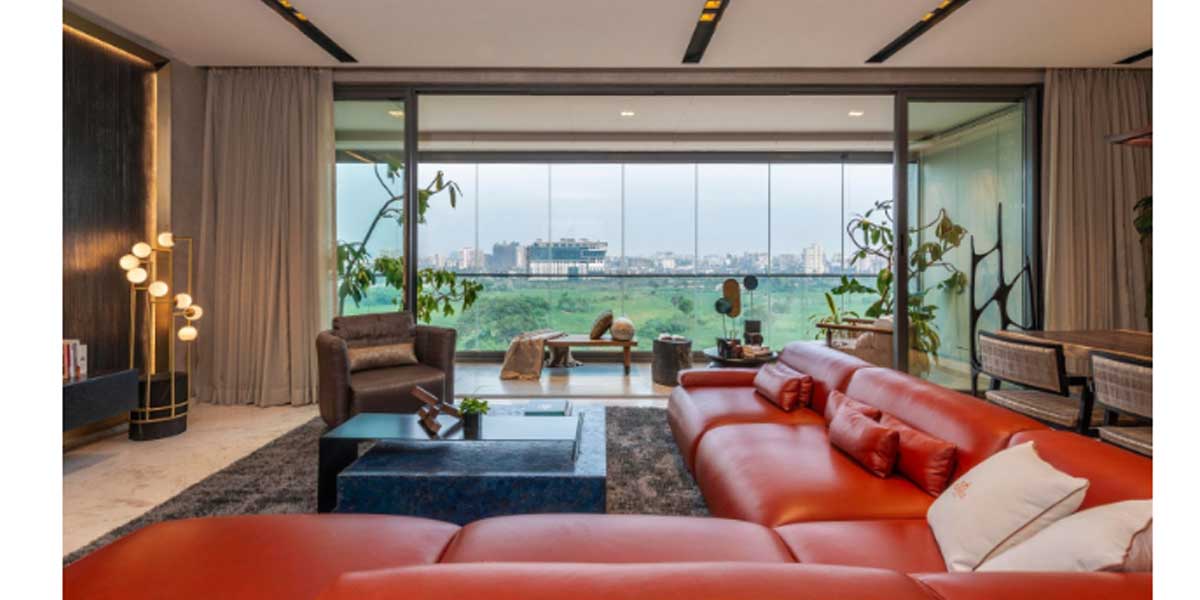When the pandemic hit India last year, two things that came to the forefront were innovation and value. Shyam Raghunandan, Managing Director, Schueco India, says, “Customers started looking for optimising costs, and the increased time spent at home changed buyer preferences for doors and windows.”
The need for more daylight, ventilation, outdoor air and sound insulation assumed greater importance during the course of the pandemic, resulting in increased investment in innovation. But, are all the demands feasible?
Catering to buyer preferences with contextuality
“We did good sales in the last year after the lockdown because we understood the requirements of customers and provided them with the right solution,” shares Prashanth BK, Senior General Manager, Prestige Estates. “Larger windows have been requested from a segment of our customers. But while large windows bring in more light and ventilation, at the same time they bring in a lot of heat unless they are not engineered.” Maintaining a balance between customer needs and practicality is important.
The growing need to stay connected to the outdoors has increased the demand for windows having sleek framing of 9-19 mm, shares Kanhai Gandhi, Partner, KNS Architects. “These windows cannot be installed everywhere. As architects, we have to work on contextual designing, where window placement should be in accordance with the location and the weather conditions.” Logical, along with aesthetical solutions, are the need of the hour.
Products that can work even in the case of a power cut, in the absence of Wi-Fi, will set the tone for future demands. According to Schmidt, not only are these extremely stylish, but will be also be a requirement to ensure safety and security of users.
Economic factors play a major role in deciding the materials to be used for windows and doors For a residential project, laminated double-glass unit is not a viable option, shares GK Venkatesh, Promoter, Nemcon Facade Consult. Keeping various factors in mind, simple clear glass with a tint and laminated gloss is suitable for residential projects. “The demand for larger panes is growing because work from home requires more light and ventilation,” he adds. “But acoustics is a an important factor that needs to be considered while choosing windows. The acoustics required for a house on the main road will be different from what is required for a gated community 10 m behind the boundary wall.”
How feasible are all-glass buildings and those where the windows hardly open?
Such designs are taken up to create landmarks, but they take you away from nature and practicality, responds Gandhi. “They require conditioned air and lack natural ventilation to cater to tropical conditions like ours.” The only advantage would be that such buildings can tackle wind pressures and rain that become crucial if you go beyond 100 m. The higher you go, the wind velocity and rain pressure increases. “To address these issues, factors like fixed glazing and minimum opening of windows help create resistance. Hence, taller buildings or towers have fixed windows with minimum openings, which eventually add to creating the looks for a landmark construction.”
To standardise or not?
“The uPVC Window and Door Manufacturers Association (UWDMA) is in the process of setting standards for uPVC profiles on windows”, informs the association's President and Managing Director of Lingel Windows and Doors Dr hc Mario Schmidt, informs us. “Standardisation can help control costs, which is pertinent for large-scale projects and the emerging segment of affordable housing.” Security and safety of humans should not be compromised while putting standards in place. UWDMA in 2016 introduced the Fabrication Guideline for correct fabrication, “and a year ago, we introduced the Installation Guideline for correct installation,” adds Schmidt. “Over the years, we have done so many workshops with fabricators to educate them about the installation process.”
According to Raghunandan, there are three pillars to standardisation. First: Standardisation of performance. For instance, customers should perceive and understand a standard such as “a window is 300 Pa resistant against water leakage,” in the same manner as the industry. Second: Standardisation of sizes, wherein, there are a certain defined set of sizes in a home that are standard, without eliminating the option of customisation. Third: Standardisation of operators, fabricators, factory workers and site installers, and their skill level. “The right balance between standardisation and customisation is the key to bringing in efficiency and value to the end-user, builder and manufacturer,” he says.
One reason why standardisation, especially of size, performance and skill, is important is because the window is an interface between civil work and masonry and the fenestration system. So, standardising an interface drives efficiency, avers Raghunandan.
While Gandhi agrees that standardisation is the way forward for a lot of housing and commercial projects, innovation, customisation and thinking out of the box are necessary for breaking away from the monotony. He believes, “For a colourful and diverse country like India, standardisation gets boring and it’s important to have choices.”
Venkatesh says, “A fine balance between standardisation and non-standardisation is required, where sizes can be standardised but options for creativity are left open, albeit with clear identified details.” For instance, window sizes can be standardised but the choice of colour for the glass can be left to the end-user. He believes that one of the advantages of freezing the size of the glass would bring about glass optimisation and reduction in the wastage of profiles.
“In the luxury and premium segment, there is a need to bring in newer solutions such as automated bug mesh, burglar alarms and sensors for doors and windows, but standardisation is what we adopt in the mass housing segment with a tinge of customisation as per customer requirement,” says Prashanth. One of the challenges that need to be addressed is the standardisation of the installation technique and investment in skill improvement of workers.
Awareness for affordability
How does digitalisation affect the cost of the product? A smart building collects information about the environment digitally and helps the user make informed decisions about controlling their environment to their preference. Windows are a part of these buildings and they should be developed to collect information such as outside temperature and light inside the room and provide relevant information to the user, opines Raghunandan. According him, awareness and understanding about the needs of buyers, then generating scale and manufacturing products can considerably bring down costs.
The cost of aluminium windows for each project based on the wind speed zone and height of the building would be different. However, the average costing of aluminium system windows would be between `7,000-9,000 per sq m, and digitalisation would move up the cost by close to 10 per cent, tells us Venkatesh.
Digitalisation is no longer an alien concept. People aspire to automation and digitalisation for lighting, curtain operations, and now doors and windows, says Gandhi. “Everything comes at a cost, and widespread awareness will help in reducing cost and making it more affordable.”
Future of the segment
Customers are expecting more choice from the design and performance perspectives. The entire supply chain is maturing, be it raw material suppliers, system suppliers, fabricators or installers. Further, people are realising that windows and doors do not just have to just sit on the walls and look pretty. They are now looking for utility in doors and windows, avers Raghunandan, and are trying to get the best by investing in digitisation. Customers are expecting more choice from the design and performance perspectives. The entire supply chain is maturing, be it raw material suppliers, system suppliers, fabricators or installers. Further, people are realising that windows and doors do not just have to just sit on the walls and look pretty. They are now looking for utility in doors and windows, avers Raghunandan, and are trying to get the best by investing in digitisation.
Investment in technology and tight turnaround time are two important factors to ensure timely completion of projects. “In our B2C segment,” reveals Schmidt, “a couple of years ago, uPVC was dominating; now, the demand for aluminium has also increased. We can see a change in the material preferences of consumers.”
“I foresee greater professionalism in each segment,” shares Venkatesh. “Designs, systems and manufacturers are becoming professional in every step of the process. Twenty years ago, the windows we used were termed as Bombay sliders, but no one uses this language today.” Undoubtedly, the future of fenestration is going to be bright.
Preferred Vendors
“We work with a closed loop of vendors, but we are in constant look for vendors who can deliver products with consistent quality and adhere to timelines,” shares Prashanth BK, Senior General Manager, Prestige Estates. “Our requirement every year is almost 50,000-60,000 windows and about 40,000 doors, and we work on tight timelines with customers. So, we look at vendors who can meet such level of requirements and perform consistently, and try not to spread ourselves across multiple vendors to ensure efficient coordination.”
Investment in R&D
“We have a strong innovation product pipeline; we have already launched some of these products,” informs Shyam Raghunandan, Managing Director, Schueco India. “We have increased our investment in R&D at the Indian and international levels, and are trying to design systems to cater to the needs of local markets and address local issues. For instance, looking at the wind performance requirements of the area.”
Adds Dr hc Mario Schmidt, Managing Director, Lingel Windows and Doors and President, uPVC Window and Door Manufacturers Association (UWDMA), “R&D for developing new glazing systems has been taken up, shares. Doors with improved safety and security features and windows that prevent water from entering the home during monsoon are being developed.”
Connecting Digitally
To reach out to its customers, Schueco India had to quickly adapt to digital reality, says its Managing Director Shyam Raghunandan. “In April and May, we conducted about 200-300 webinars with our architect partners and builders, and also trained our fabricator partners to use digital media.”
“Our revenue mainly comes from B2C, where people want to feel the products they plan on buying,” adds Dr hc Mario Schmidt, Managing Director, Lingel Windows and Doors and President, uPVC Window and Door Manufacturers Association (UWDMA). “We conducted many webinars with architects and our team members to motivate them to use innovative platforms to connect with consumers.”
On the industry level, Prashanth BK, Senior General Manager, Prestige Estates, says, it has initiated several steps to adopt digitisation that will certainly help in better communication between various stakeholders in the value chain. “Digital dashboard platforms for the manufacturer, installer, developer and customer to keep a tab on developments can infuse transparency in the process.”-By Praharshi Saxena




















